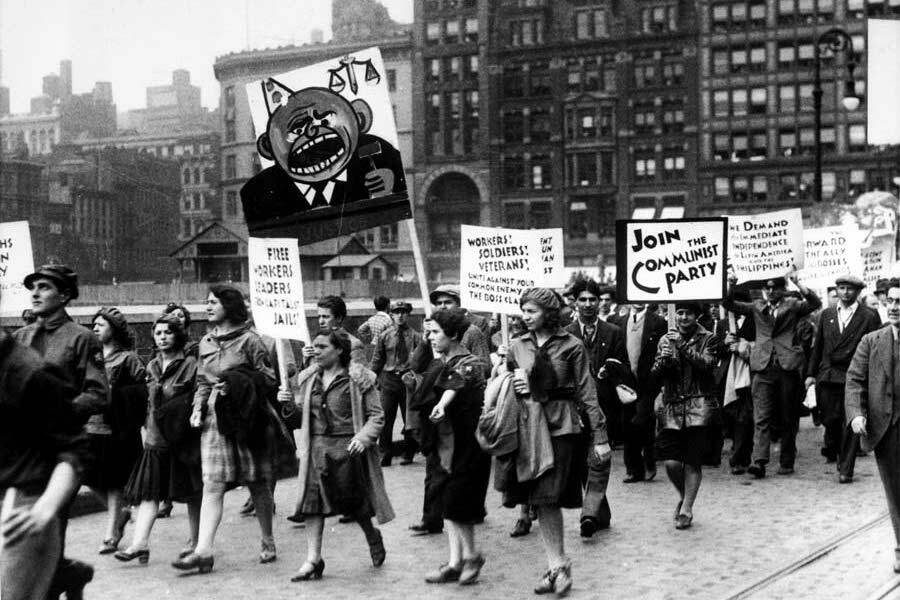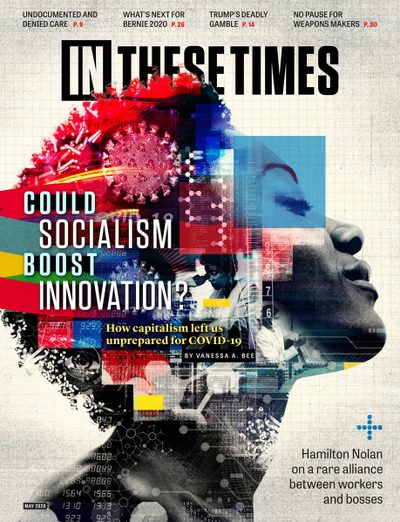What Today’s Socialists Can Learn From the Heyday of American Communism
A 43-year-old classic text of Communist history has been rereleased this month. Young democratic socialists should dig in.
Micah Uetricht

After Vivian Gornick’s The Romance of American Communism first appeared in 1977, it’s no surprise that In These Times—founded as a socialist newsweekly the year prior — reviewed it. Gornick is an important chronicler of the second-wave feminist movement with more than a dozen books to her name. Romance, her second, helped reshape the historiography of the Communist Party in the United States, finally including not just the Soviet Union’s control over the American Communist Party but its members’ own organizing and the lives they lived within the party, which were far richer than anti-communist writers let on.
The book, a collection of oral histories of American Communist Party members and their experiences mostly in the party’s heyday in the 1930s through its decline two decades later, has been reissued this month by the left publisher Verso with a new introduction by the author.
Gornick was born during the height of the party’s influence in 1935 and grew up in New York’s Lower East Side. With its 3,000 members, she writes, “Never before or since have American Communists been more like the fish that swims in the sea of the people.” Her parents were Ukrainian-Jewish immigrants and socialist “fellow travelers,” while other relatives were party members.
In Gornick’s world, the party stood “at the center of the globe” and were seen as vital members of her community even by those who disagreed with them. Historian Maurice Isserman quotes one of Gornick’s interviewees in his March 1978 review for In These Times: “No matter what happened politically in the ’30s, on the Lower East Side everyone always wanted to know what the Communists were doing. … Even when they hated us, we were still their own.”
Yet when Gornick read about the party at the time, by writers ranging from anti-Stalinist socialists to hard-right reactionaries, she saw a typical party member depicted as “a creature who walks through one door a warm human individual and emerges through another a rubber-stamped robot.” That didn’t square with her experience: “The Communist experience was, both in its glory and in its debasement, an awesome move toward humanness; an immense and tormented effort of the heart, will and brain that cried out ‘I must have justice or I will die.’ ”
So Gornick set out to capture that experience through conversations with dozens of members throughout the country, from party intellectuals to former party functionaries to shop-floor union militants.
How did Gornick’s telling hold up? Not well, according to Isserman, a graduate student at the time (who would become a premier historian of the U.S. Left). Isserman enjoyed some of Gornick’s anecdotes and appreciated her nuance, but ultimately panned the book. Gornick’s portrait of the passionate highs of some party members were too high and the dejected lows of other members too low, Isserman thought: “[Gornick] ends up developing a set of stereotypes of the Communist experience as flat and unconvincing as those churned out by the sectarian and witch-hunting schools of communist historiography.”
In the decades since, young socialists like me have disagreed sharply. Despite being long out of print, Romance gained a kind of cult status among members of the Democratic Socialists of America (DSA), especially since the U.S. socialist movement’s recent rebirth.
Political scientist Corey Robin summed up why in New York magazine in 2019: “Yes, Gornick was talking about members of the Communist Party, but she was really talking about everyone in the socialist tradition who was fundamentally committed to creating a world without capitalism [and] why they saw their personal destiny bound up with that struggle.”
In 2015, I organized a reading group on the book that met in In These Times’ Chicago office. In reading and rereading Romance, we didn’t see “flat and unconvincing” portraits of socialist militants. We saw ourselves.
Disillusioned by rampant inequality and desiccated democracy, and inspired by a new sense of possibility following the 2016 Bernie Sanders campaign, we threw ourselves into organizing, from labor campaigns to affordable housing fights and battles for immigrant rights. When the 2020 Bernie campaign launched, we threw ourselves into that, too.
Today, Gornick isn’t as enthused about the new socialist wave as I am. (Nor about Bernie — she recently told Jewish Currents, “He’s old and he’s Jewish and he rants and he raves.”) But she writes in the new introduction that the Communist Party “induced in the most ordinary of men and women a sense of one’s own humanity that made life feel large; large and clarified.” Through DSA and Bernie, our humanity, too, felt large and clarified.
Gornick also captures the devastation that Stalin’s crimes wrought upon this process of personal transformation. Many of her interviewees tell of their wrenching disillusionment upon learning that the tales of gulags and mass murder in the Soviet Union, previously written off as imperialist lies spread by a conniving Uncle Sam, were true. Under Stalin, the Soviet Union killed at least 2 million political opponents, including the deaths in the forced labor camps where 18 million Soviet citizens were sent. Most of the people Gornick interviewed were embittered and left the party soon after; many never returned to politics.
Today’s democratic socialists have not put hope in a far-off workers’ paradise. We are committed to democracy and tend to be skeptical of utopian promises. But we are desperate for an affirmation that our newfound lives as activists are noble and worthwhile — as we continue to run up against the most powerful capitalist class in the world and a Democratic Party establishment hell-bent on stopping democratic-socialist politicians as inspiring as Bernie Sanders and Alexandria Ocasio-Cortez.
It isn’t that Isserman’s assessment was wrong; a sober, academic account of the party may indeed offer a fuller, more balanced picture of its inter-nal life. But sometimes sobriety and nuance aren’t what members of nascent movements need — sometimes, they need their passions affirmed and stoked. The Romance of American Communism does just that.
Views expressed are the author’s. As a 501©3 nonprofit, In These Times does not support or oppose candidates for political office.
Micah Uetricht is an editor at Jacobin magazine. He is a contributing editor and former associate editor at In These Times, and the author of Strike for America: Chicago Teachers Against Austerity and coauthor of Bigger Than Bernie: How We Go From the Sanders Campaign to Democratic Socialism, and is currently at work on a book on New Leftists who took jobs in industries like steel and auto to organize on the shop floor.









